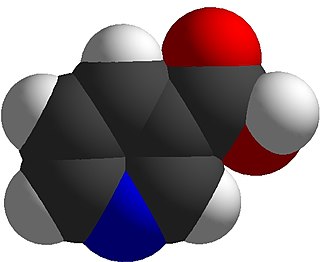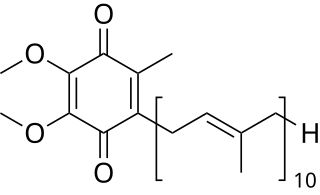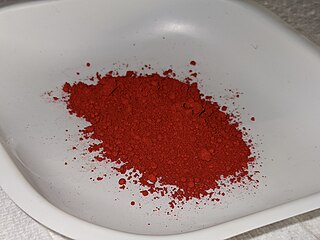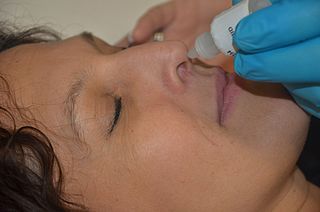
Nicotinamide (INN, BAN UK) or niacinamide (USAN US) is a form of vitamin B3 found in food and used as a dietary supplement and medication. As a supplement, it is used orally (swallowed by mouth) to prevent and treat pellagra (niacin deficiency). While nicotinic acid (niacin) may be used for this purpose, nicotinamide has the benefit of not causing skin flushing. As a cream, it is used to treat acne, and has been observed in clinical studies to improve the appearance of aging skin by reducing hyperpigmentation and redness. It is a water-soluble vitamin.

Peppermint is a hybrid species of mint, a cross between watermint and spearmint. Indigenous to Europe and the Middle East, the plant is now widely spread and cultivated in many regions of the world. It is occasionally found in the wild with its parent species.

Vitamins are organic molecules that are essential to an organism in small quantities for proper metabolic function. Essential nutrients cannot be synthesized in the organism in sufficient quantities for survival, and therefore must be obtained through the diet. For example, vitamin C can be synthesized by some species but not by others; it is not considered a vitamin in the first instance but is in the second. Most vitamins are not single molecules, but groups of related molecules called vitamers. For example, there are eight vitamers of vitamin E: four tocopherols and four tocotrienols.

Nicotinic acid, or niacin, is an organic compound and a vitamer of vitamin B3, an essential human nutrient. It is produced by plants and animals from the amino acid tryptophan. Niacin is obtained in the diet from a variety of whole and processed foods, with highest contents in fortified packaged foods, meat, poultry, red fish such as tuna and salmon, lesser amounts in nuts, legumes and seeds. Niacin as a dietary supplement is used to treat pellagra, a disease caused by niacin deficiency. Signs and symptoms of pellagra include skin and mouth lesions, anemia, headaches, and tiredness. Many countries mandate its addition to wheat flour or other food grains, thereby reducing the risk of pellagra.

Coenzyme Q10 (CoQ10), also known as ubiquinone, is a naturally occurring biochemical cofactor (coenzyme) and an antioxidant produced by the human body. It can also be obtained from dietary sources, such as meat, fish, seed oils, vegetables, and dietary supplements. CoQ10 is found in many organisms, including animals and bacteria.

Sunscreen, also known as sunblock, sun lotion or sun cream, is a photoprotective topical product for the skin that helps protect against sunburn and prevent skin cancer. Sunscreens come as lotions, sprays, gels, foams, sticks, powders and other topical products. Sunscreens are common supplements to clothing, particularly sunglasses, sunhats and special sun protective clothing, and other forms of photoprotection.

Menthol is an organic compound, specifically a monoterpenoid, that occurs naturally in the oils of several plants in the mint family, such as corn mint and peppermint. It is a white or clear waxy crystalline substance that is solid at room temperature and melts slightly above. The main form of menthol occurring in nature is (−)-menthol, which is assigned the (1R,2S,5R) configuration.

Pellagra is a disease caused by a lack of the vitamin niacin (vitamin B3). Symptoms include inflamed skin, diarrhea, dementia, and sores in the mouth. Areas of the skin exposed to friction and radiation are typically affected first. Over time affected skin may become darker, stiffen, peel, or bleed.
B vitamins are a class of water-soluble vitamins that play important roles in cell metabolism and synthesis of red blood cells. They are a chemically diverse class of compounds.

β-Carotene (beta-carotene) is an organic, strongly colored red-orange pigment abundant in fungi, plants, and fruits. It is a member of the carotenes, which are terpenoids (isoprenoids), synthesized biochemically from eight isoprene units and thus having 40 carbons.

A topical medication is a medication that is applied to a particular place on or in the body. Most often topical medication means application to body surfaces such as the skin or mucous membranes to treat ailments via a large range of classes including creams, foams, gels, lotions, and ointments. Many topical medications are epicutaneous, meaning that they are applied directly to the skin. Topical medications may also be inhalational, such as asthma medications, or applied to the surface of tissues other than the skin, such as eye drops applied to the conjunctiva, or ear drops placed in the ear, or medications applied to the surface of a tooth. The word topical derives from Greek τοπικόςtopikos, "of a place".

Hartnup disease is an autosomal recessive metabolic disorder affecting the absorption of nonpolar amino acids. Niacin is a precursor to nicotinamide, a necessary component of NAD+.

Photoaging or photoageing is a term used for the characteristic changes to skin induced by chronic UVA and UVB exposure. Tretinoin is the best studied retinoid in the treatment of photoaging.
Sheldon R. Pinnell was an American dermatologist and physician-scientist who served as the J. Lamar Callaway Professor of Dermatology at Duke University. His research involves sun protection, photoaging, collagen chemistry, and topical percutaneous absorption of antioxidants. In 2013, he was made an honorary member of the Society of Investigative Dermatology.

Nicotinamide riboside (NR, SR647) is a pyridine-nucleoside and a form of vitamin B3. It functions as a precursor to nicotinamide adenine dinucleotide, or NAD+, through a two-step and a three-step pathway.

Vitamin B3, colloquially referred to as niacin, is a vitamin family that includes three forms, or vitamers: nicotinic acid (niacin), nicotinamide (niacinamide), and nicotinamide riboside. All three forms of vitamin B3 are converted within the body to nicotinamide adenine dinucleotide (NAD). NAD is required for human life and people are unable to make it within their bodies without either vitamin B3 or tryptophan. Nicotinamide riboside was identified as a form of vitamin B3 in 2004.
Nanomaterials are materials with a size ranging from 1 to 100 nm in at least one dimension. At the nanoscale, material properties become different. These unique properties can be exploited for a variety of applications, including the use of nanoparticles in skincare and cosmetics products.
Topical gels are a topical drug delivery dosage form commonly used in cosmetics and treatments for skin diseases because of their advantages over cream and ointment. They are formed from a mixture of gelator, solvent, active drug, and other excipients, and can be classified into organogels and hydrogels. Drug formulation and preparation methods depend on the properties of the gelators, solvents, drug and excipients used.
α-Zeacarotene (alpha-zeacarotene) is a form of carotene with a β-ionone ring at one end and a ζ-ionone ring at the opposite end. It is an intermediate in the biosynthesis of various carotenoids and plays a crucial role in the metabolic pathway leading to the production of lycopene and other important carotenoids.
















